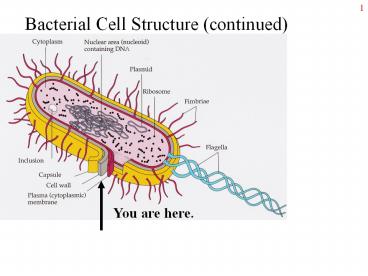Bacterial Cell Structure (continued) - PowerPoint PPT Presentation
Title:
Bacterial Cell Structure (continued)
Description:
Title: Effect of osmotic pressure on cells Author: DGILMORE Last modified by: Dr.s Gilmore Created Date: 1/24/2004 6:45:31 PM Document presentation format – PowerPoint PPT presentation
Number of Views:113
Avg rating:3.0/5.0
Title: Bacterial Cell Structure (continued)
1
Bacterial Cell Structure (continued)
You are here.
2
Peptidoglycan structure
- Bacteria typically face hypotonic environments
- Peptidoglycan provides support, Limits expansion
of cell membrane - Bacteria need other protection from hypertonic
situations
3
Gram negative cell wall
4
Outer membrane
- Lipid bilayer membrane
- Inner and outer leaflets
- Inner leaflet made of phospholipids outer
leaflet is made of lipopolysaccharide (LPS) - LPS endotoxin
- Proteins for transport of substances
- Porins transmembrane proteins
- Barrier to diffusion of various substances
- Lipoprotein anchors outer membrane to PG
5
Structure of LPS
extends from cell surface.
contains odd sugars e.g. KDO.
Gln-P and fatty acids take the place of
phospholipids.
www.med.sc.edu85/fox/ cell_envelope.htm
6
Periplasmic Space
www.arches.uga.edu/emilyd/ theory.html
7
Periplasmic space
- A lot like cytoplasm, with
- Peptidoglycan layer
- Proteins that aid in transport
- Proteins that break down molecules
- Proteins that help in synthesis.
8
Glycocalyx capsules and slime layers
Sugar covering capsules are firmly attached,
slime layers are loose.
Multiple advantages to cells prevent
dehydration absorb nutrients protection from
predators, WBCs protection from biocides (as
part of biofilms) attachment to surfaces and
site of attachment by others. S-layers are
highly structured protein layers that function
like capsules
cell
capsule
www.activatedsludge.info/ resources/visbulk.asp
9
Fimbriae and pili
Both are appendages made of protein Singular
fimbria, pilus Both used for attachment Fimbriae
to surfaces (incl. host cells) and other
bacteria. Pili to other bacteria for exchanging
DNA (sex).
www.ncl.ac.uk/dental/oralbiol/ oralenv/images/sex1
.jpg
10
Flagella
- Flagella protein appendages for swimming through
liquid or across wet surfaces. - Rotate like propellers.
- Different from eukaryotic flagella.
- Arrangements on cells
- polar,
- Lophotrichous,
- amphitrichous,
- peritrichous.
www.ai.mit.edu/people/ tk/ce/flagella-s.gif
www.bmb.leeds.ac.uk/.../icu8/ introduction/bacteri
a.html
11
Prokaryotic vs. eukaryotic flagella
- Prokaryotic flagella
- Made of protein subunits
- Protrude through cell wall and cell membrane.
- Stiff, twirl like a propeller
- Eukaryotic flagella
- A bundle (92) of microtubules (made of protein)
- Covered by cell membrane
- Whipping action
www.scu.edu/SCU/Departments/ BIOL/Flagella.jpg
img.sparknotes.com/.../monera/ gifs/flagella.gif
12
Chemotaxis
- Bacteria change how they move in response to
chemicals - Bacteria move toward attractants (e.g.
nutrients). - Bacteria move away from repellants.
- In this figure, bacteria use up nutrients in the
agar, then move outward to where more nutrients
are, producing rings of growth.
http//class.fst.ohio-state.edu/fst636/SP2004_must
afa/chemotaxis20demo_SP04.htm
13
Runs and Tumbles bacteria find their way
http//www.bgu.ac.il/aflaloc/bioca/motil1.gif
14
Spirochetes have internal flagella
- Axial filament a bundle of internal flagella
- Between cell membrane and outer membrane in
spirochetes - Filament rotates, bacterium corkscrews through
medium - Some bacteria move without flagella
- Gliding
- No visible structures, requires solid surface
- Slime usually involved.
15
Axial filaments
http//images.google.com/imgres?imgurlhttp//micr
ovet.arizona.edu/Courses/MIC420/lecture_notes/spir
ochetes/gifs/spirochete_crossection.gifimgrefurl
http//microvet.arizona.edu/Courses/MIC420/lecture
_notes/spirochetes/spirochete_cr.htmlh302w400
sz49tbnidBOVdHqepF7UJtbnh90tbnw119start1
prev/images3Fq3Daxial2Bfilament2Bbacteria26
hl3Den26lr3D26sa3DG
16
Gliding Motility
Movement on a solid surface. No visible
organelles of locomotion. Cells produce, move in
slime trails. Unrelated organism
glide myxobacteria, flavobacteria,
cyanobacteria appear to glide by different
mechanisms. Cells glide in groups, singly,
and can reverse directions.
www.microbiology.med.umn.edu/ myxobacteria/trails.
jpg
17
From the membrane in the bacterial cytoplasm
- Cytoplasm is a gel made of water, salts, LMW
molecules, and lots of proteins. - DNA nucleoid, w/ proteins
- Plasmids small circular DNA
- Ribosomes site of protein synthesis.
Cytoplasm may also contain inclusions, gas
vacuoles, extended membrane systems, or
magnetosomes. But generally NO membrane-bound
organelles.
18
Inclusions and granules
- Storage molecules found as small bodies within
cytoplasm. - Can be organic (e.g. PHB or glycogen) or
inorganic (Sulfur, polyphosphate. - PHB, a type of PHA, degradable plastic
(polyester) glycogen, a polymer of glucose. - Sulfur, a metabolic by-product polyphosphate,
polymer of PO4
www.qub.ac.uk/envres/EarthAirWater/
phosphate_removal.htm
19
Magnetosomes
Membrane coated pieces of magnetite, assist
bacteria in moving to microaerophilic
environments. An organelle? North is
down. Magnetospirillum magnetotacticum
www.calpoly.edu/rfrankel/ mtbphoto.html
20
How things get in (and out) of cells
- Eukaryotic cells
- Have transport proteins in membrane
- Have a cytoskeleton made of microtubules
- Allows for receptor mediated endocytosis,
phagotcytosis, etc. - Cell membrane pinches in, creates vesicle
- Prokaryotic cells
- Have very little cytoskeleton
- Can NOT carry out endocytosis
- Entry of materials into cell by diffusion or
transport processes ONLY.
21
Illustrations entry into cells
Both prokaryotes and eukaryotes.
Only eukaryotes.
http//bio.winona.msus.edu/bates/genbio/images/end
ocytosis.gif http//www.gla.ac.uk/jmb17n/Teaching
/JHteaching/Endocytosis/figures/howdo.jpg
22
How molecules get through the membrane
Small molecules like gases can diffuse through
the bilayer. Larger or more hydrophilic
molecules require transport proteins.
Active transport requires metabolic energy.
23
Review of eukaryotic cells
Mitochondrion Plasmalemma (cell
membrane)nucleus, ribosomeslysozomeendoplasmic
reticulumgolgi body
www.steve.gb.com/ science/cell_biology.html































